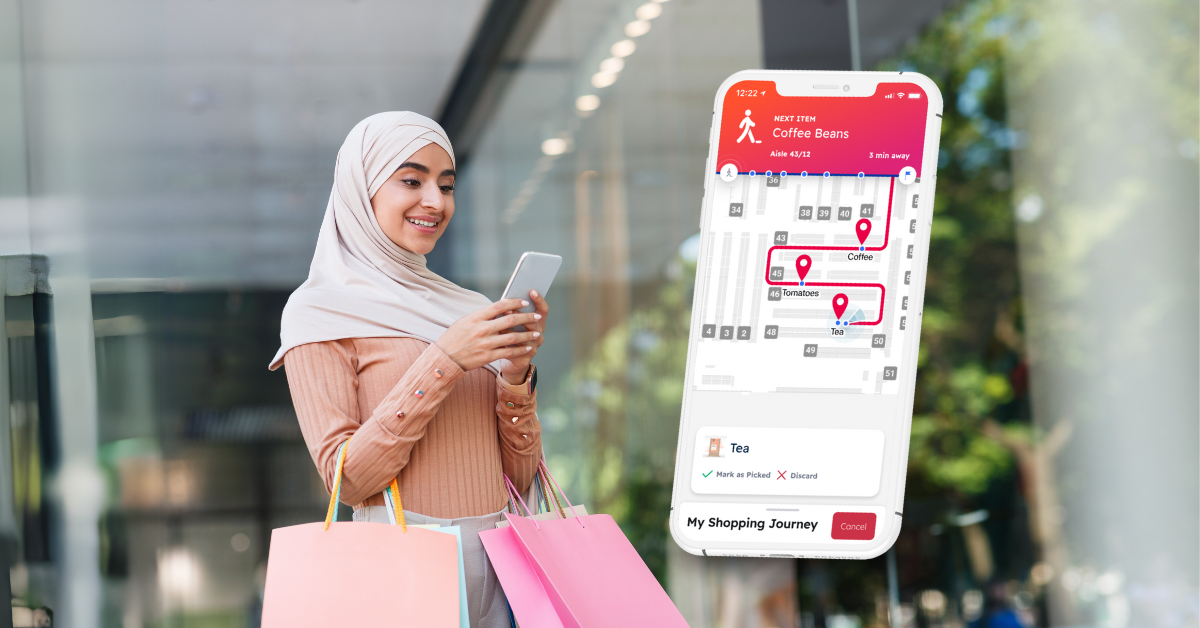What Is Beacon Technology?
Beacons are one of the most developed IoT technology devices, often used for proximity marketing, which is essentially based on Bluetooth beacon technology. They are simple, one-directional transmitters that are used to mark places. They function as a tool for detecting individuals’ presence through wireless transmitters.
Beacon technology essentially provides contextual information to its users, allowing businesses to actively engage with their customers. It works in accordance with indoor and outdoor navigation systems. An identifier in the form of a unique ID is broadcast from these small Bluetooth beacon technology wireless transmitters and, in return, is picked up by nearby devices. This IoT beacon technology makes interactions simple and effective.
How Do Beacons Work?
This technology functions through beacon signals. Beacon-based identifiers, which are unique ID numbers are sent through low-energy Bluetooth technology to smart devices such as mobile phones. These unique ID numbers then get recognized by the devices in the designated area set by the installed beacons. For example, a potential client passing by a local restaurant may receive messages about special offers sent to their mobile phone.
The different types of beacons create multiple opportunities. There are multiple sizes of beacons; including the standard ones suitable for indoor tracking, portable or small beacons that are the size of a credit card, or USB beacons that are suitable for asset tracking. Beacons are convenient as they can be used in a variety of locations such as stores, offices, public buildings, or public transport vehicles.
What is Beacons Marketing & Advertising?
Beacon marketing and advertising leverage Bluetooth beacon technology to send personalized messages and promotions to users’ smartphones based on their proximity to physical locations or products. The technology enables businesses to engage with customers in real time, providing relevant information, discounts, or special offers as they enter specific areas or approach particular items. The latest technology enhances customer experiences, drives foot traffic, and boosts sales by delivering personalized content right to the customer, making it a powerful tool for businesses seeking to connect with their target audiences in a highly targeted and location-aware manner.
History of Beacon Technology
Beacon history, Beacon technology was first launched in 2013 with the introduction of iBeacon by Apple alongside iOS 7. Apple used beacons for in-store notifications which were sent to the customers. Since then, Beacon Solutions has been integrated in many stores in the retail sector.
In 2015, several famous mobile applications such as Facebook or Shazam also started to use beacons. Google also launched its own platform, Eddystone, to produce location-based content as the new rival of iBeacon.
Later on, Eddystone EID was announced by Google in 2016 with the purpose of better safeguarding users upon connection. One of the distinctive characteristics that Eddystone brings to the industry is the type of signals it transmits. It can produce four classes of signals whereas iBeacon sends out only one. Eddystone is also compatible with iOS and Android devices.
The requirement to download an additional mobile application as part of proximity marketing strategies has resulted in decreased popularity of beacon technology over time. Google has been working on making proximity marketing possible without the obligation of downloading another application.
Recently, Google’s Project Beacon has been developed as the next generation of this technology, which integrates multiple actions into one beacon. Apart from the identification of precise location signals and the release of targeted messages, the Google Cloud Platform software has become the ultimate system manager. Now, all beacons can be monitored by a single authority through this platform. It enables resource distribution and novel experiences integrated with other applications.
Battery Life of Beacon Devices
The battery life of a beacon device can vary depending on a number of factors, including:
The type of beacon: There are two main types of beacons, Bluetooth Low Energy (BLE) beacons and Ultra Wideband (UWB) beacons. BLE beacons are more common and have a battery life of 1-48 months, while UWB beacons have a battery life of 1-2 years.
The beacon’s settings: The beacon’s settings can also affect its battery life. For example, beacons that transmit more frequently will have a shorter battery life than beacons that transmit less frequently.
The environment where the beacon is used can also affect its battery life. For example, beacons that are used in cold or hot environments will have a shorter battery life than beacons that are used in moderate environments.
In general, expect a BLE beacon to have a battery life of 1-2 years if it is used with the default settings in a moderate environment.
Evolution of Beacon Technology
Bluetooth Low Energy (BLE) was introduced in 2010 as a new category of Bluetooth designed for low-power applications. Bluetooth 4.0 BLE had a data throughput of 1Mbps and a range of up to 100 meters. (reference: https://www.sciencedirect.com/topics/engineering/gaussian-frequency-shift-keying)
Bluetooth 5.0 is an improvement from the previous BLE standards. Bluetooth 5.0 was also released in 2016 and significantly improved the performance of BLE. It has a data throughput of up to 2Mbps and a range of up to 400 meters. Bluetooth 5 offers four different data rates to accommodate a variety of transmission ranges: 2Mbps, 1Mbps, 500kbps, and 125kbps. The flexibility in data speeds offered by Bluetooth 5 allows low-powered products to send even more sophisticated data to the end user. Bluetooth 5.0 also offers new features such as broadcast audio and improved security.
The latest version of Bluetooth, Bluetooth 5.4, was released in February 2023. It further improves the performance of BLE with a data throughput of up to 4Mbps and a range of up to 240 meters. Bluetooth 5.4 also introduces new features such as enhanced power saving and improved coexistence with other wireless technologies.
The evolution of beacon technology has been driven by the need for low-power, long-range wireless communication. Bluetooth BLE has been a key enabler of this technology, and the latest version, Bluetooth 5.4, offers even more performance and features for a wide range of applications.
What Are the Benefits of Beacon Technology?
Beacon technology provides retail solutions that benefit both front and back-end users within a company. It helps businesses streamline operations, gather valuable data, implement effective marketing strategies, and create personalized customer experiences. Retail stores frequently integrate beacon technology into their shopping experiences through mobile apps, offering numerous advantages such as cost-effectiveness, easy installation, personalized customer engagement, high compatibility, and reliability.
Beacon technology also offers a way to stimulate publicity through better visibility, increased number of reviews, and refined location. Advanced customer experiences can be achieved with the use of beacons as it enables people to find and engage with your business more easily.
In addition to online benefits, the development of offline features also makes it possible to access deeper insights into users’ activities even when they are not online. Beacons can be connected to other tools such as Google Ads which helps keep track of offline attributions. Understanding users’ exact interaction points lets businesses build more effective advertising strategies. Information on customer behavior through accurate and reliable data allows for creating specially tailored campaigns. Therefore, it gives you the right mechanism to approach customers and drive their visits to your business. Collecting such data on your marketing activities can help you to determine what is working best.
Beacon solutions are also used to merely send out any significant information that you want your users to know. You can adjust the content of these messages; whether it’s about special discounts, individual offers, or competitions. In-store and location-based beacon devices are often utilized for single-product discounts. As mobile devices have become an essential part of our daily lives, proximity marketing will continue to provide more opportunities to businesses and end-users.
Indoor Wayfinding & Navigation using BLE Beacons – Beacons are used for indoor wayfinding and navigation similar to what Google Maps uses GPS signals. This is also called indoor GPS.
Indoor Positioning and Tracking using BLE Beacons – Beacons are used for indoor position and tracking to locate important assets and monitor the presence of people (facility personnel, students, staff attendance, …) using BLE asset tags and BLE wearables. In comparison to traditional RFID technology for real-time location services (RTLS) use cases, BLE Beacons are much cost cost-effective and many enterprises including hospitals consider the BLE Beacon technology for indoor tracking. Moreover, the Enterprise Wireless Access Points are now providing BLE Gateway capabilities, which is another benefit of utilizing the same infrastructure to provide more use cases on tracking and indoor positioning services.
Indoor IoT Services using BLE Beacons – BLE Beacon tags and sensors are used for indoor IoT applications and use cases. Telemetry sensors provide environmental monitoring, relative humidity, temperature, water leakage, gas leakage, etc.
What Are the Limitations of Beacon Technology?
Beaconing signals are weaker than Wi-Fi signals. Fluctuations in Bluetooth signal strength have an impact on the quality and reliability of some applications. Building structures, including concrete and steel, as well as the human body, affect the signal quality of the BLE beacons. Therefore, the location precision depends on the deployment environment and use cases that are utilized with BLE beacon technology.





